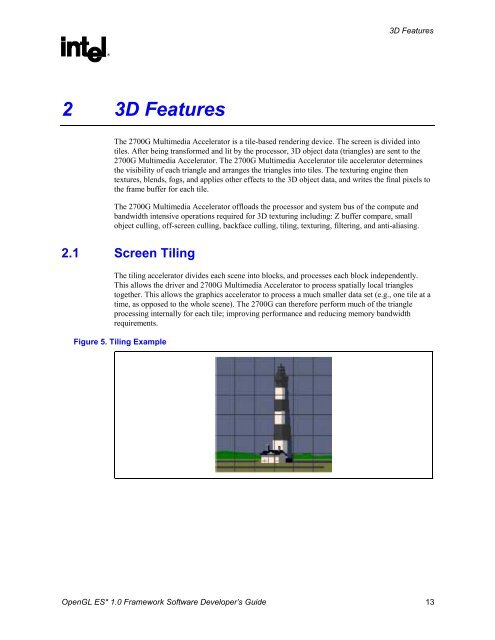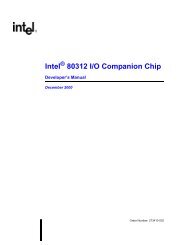OpenGL ES* 1.0 Framework Software Developer's Guide
OpenGL ES* 1.0 Framework Software Developer's Guide
OpenGL ES* 1.0 Framework Software Developer's Guide
You also want an ePaper? Increase the reach of your titles
YUMPU automatically turns print PDFs into web optimized ePapers that Google loves.
3D FeaturesR2 3D FeaturesThe 2700G Multimedia Accelerator is a tile-based rendering device. The screen is divided intotiles. After being transformed and lit by the processor, 3D object data (triangles) are sent to the2700G Multimedia Accelerator. The 2700G Multimedia Accelerator tile accelerator determinesthe visibility of each triangle and arranges the triangles into tiles. The texturing engine thentextures, blends, fogs, and applies other effects to the 3D object data, and writes the final pixels tothe frame buffer for each tile.The 2700G Multimedia Accelerator offloads the processor and system bus of the compute andbandwidth intensive operations required for 3D texturing including: Z buffer compare, smallobject culling, off-screen culling, backface culling, tiling, texturing, filtering, and anti-aliasing.2.1 Screen TilingThe tiling accelerator divides each scene into blocks, and processes each block independently.This allows the driver and 2700G Multimedia Accelerator to process spatially local trianglestogether. This allows the graphics accelerator to process a much smaller data set (e.g., one tile at atime, as opposed to the whole scene). The 2700G can therefore perform much of the triangleprocessing internally for each tile; improving performance and reducing memory bandwidthrequirements.Figure 5. Tiling Example<strong>OpenGL</strong> <strong>ES*</strong> <strong>1.0</strong> <strong>Framework</strong> <strong>Software</strong> Developer’s <strong>Guide</strong> 13
















